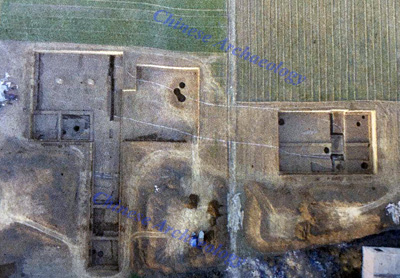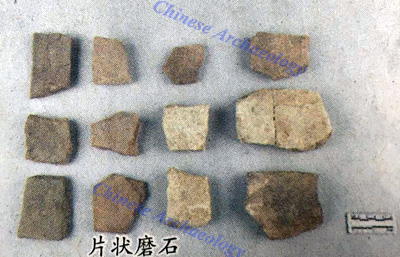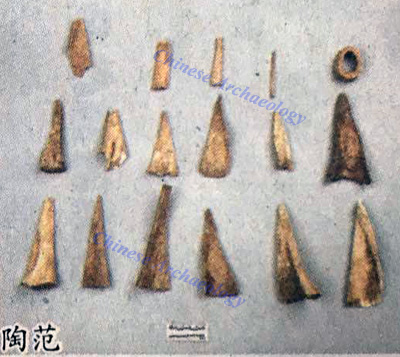Information
Bronze casting and bone tool manufacturing workshop discovered at Huanbei City Site of Shang Dynasty in Anyang, Henan Province
Summary: From June to August 2016, the Institute of Archaeology Chinese Academy of Social Sciences conducted archaeological excavation work at the Huanbei City Site of the Shang Dynasty in Anyang. The excavation area was located outside the Palace of Huanbei City,
Bronze casting and bone tool manufacturing workshop discovered at Huanbei City Site of Shang Dynasty in Anyang, Henan Province
From:Chinese Archaeology Writer: Date:2017-03-13
From June to August 2016, the Institute of Archaeology Chinese Academy of Social Sciences conducted archaeological excavation work at the Huanbei City Site of the Shang Dynasty in Anyang. The excavation area was located outside the Palace of Huanbei City, 570 meters beyond the northern palace city wall. Two annual excavation areas covering 2547 square meters were located to the south of the main city wall, at a distance of 500 meters from the northern wall of the main city.

Aerail photo of the the Huanbei City Site during excavation in the year of 2015 and 2016
Five house foundations at the Huanbei City Site of the Shang Dynasty
Rammed earth structural foundations containing many different materials, including calcium carbide, a large number of pottery fragments, charcoal, and other debris were found, and the hardness of the rammed earth was not high. Due to the excavation area limitations, the entire area was not excavated completely; therefore, the scope and arrangement of columns remain unclear.
The road
There were 9 roads, including 2 Ming-Qing period roads, 4 Sui-Tang period roads, and three Huanbei period (Shang Dynasty) roads (L7, L8, L9). The scope of the Huanbei period roads was quite small. The accumulation of road soil is very thin, suggesting it was probably either a temporary roadwithin the settlement or a road formed by long term, repeated trampling by humans.
Ash ditches
There were eight ash ditches. DitchesG1-G6 were from the Warring States period; G7 and G8 were from the Huanbei period. Previously, G8 was mistakenly thought to be rammed earth remnants, but no plinths and round rammed marks, etc. were found, and after multiple inspections and verifications, it was ultimately determined that this was a ditch with multiple sedimentation layers. The width of the ditch varied and the accumulated thickness of individual layers within the ditch was neither evenly distributed nor standard.

Flake-shape griding stone
Ash pits
361 ashpits (including 15 later period pits from the Sui-Tang dynasties and Warring States periods), and 7 water wells were discovered. There were more ash pits from the Huanbei period than from other periods, and pits contained many objects, including pottery pots, earthen li [three-legged cooking vessel], gui food vessel, basins, cauldrons, and other broken pottery fragments. During the excavation of the northern part of the area, a great amount of bronze casting remnants, clay molds and models, millstones, nozzles from pottery bellows, chunks of a destroyed furnace wall, and copper slag, as well as remnants of bone tools, both finished and unfinished products, bone materials, waste products, and other leftovers and scraps were discovered in the ash pits. In addition, a large quantity of pits in the north-central area had a concave depression at their bottom. It is speculated that these might possibly have been washing pits for the model stage [of pottery making]. Six of the seven water wells were concentrated within two square units. Such a concentration of wells would have created a water supply exceeding what was needed for daily life activities, so the water wells might also have had something to do with handicraft production.

Blast nozzle found in the site
Tombs
There were 45 tombs, among which one dated to the Qing Dynasty, 6 to the Sui Dynasty, and 38 to the Huanbei period of the Shang Dynasty.
The Huanbei period tombs have a concentrated distribution. Tomb structures were not big; M10 was the largest, measuring 3.2 meters long and 2.2 meters wide. The remaining tombs all measured 2 meters long and 0.8 meters wide. The majority of tombs had an east-west orientation, and the number of tomb occupants buried in a prone position was comparatively high. Tomb grave goods were comparatively few because some of them had been robbed. Individual tombs had pottery li [three-legged cooking vessel], cowrie shells, etc.
From analysis of the unearthed artifacts, water wells, washing pits for the model stage, and so forth, the remains here are probably from a bronze and bone workshop of the Huanbei period of the Shang dynasty. Related remains are distributed mainly in the north central part of the excavation area, where many small fragments of red-brown, low heated pottery models were unearthed. Based on the small amounts of clay-mold forms present and visible patterns, this was a workshop for casting bronze ritual objects. The animal bone used to make the bone tools showed signs of being processed; from this, the bone tool manufacturing process from that time can be understood.

Bone materials
Academic Significance
This is the largest excavation outside the palace of Huanbei City, and gains were extremely abundant.
The first discovery of the bronze casting, bone tool manufacturing workshop gives us a clear understanding of the positional relationships between the handicraft manufacturing area, the main city, and the palace, according to their layout. Taking the handicrafts workshops of Erlitou site, Zhengzhou City of Shang dynasty, Yixu (Ruins of Yin), etc. into consideration, this handicraft workshop distribution allows us to have a more profound understanding of handicraft production area layout in the three earliest dynasties.
The bronze casting, bone tool manufacturing workshop areas at Huanbei City of Shang dynasty were relatively concentrated together, very similar to Yinxu ruins. This layout style is a traditional one that had been passed on from former times and is related to how handicraft production was supervised.
This bronze casting workshop discovery fills a blank space where Middle Shang period bronze ritual object workshops would be; it’s possible this discovery even furthers research on the evolution and development of bronze casting technology from the early Shang periodZhengzhou City to late Shang period Yinxu ruins. For research, this provides firm and substantial material on the course of progress during the first peak of Chinese bronze manufacture in Yinxu period. (Translator: Grace Warren)

Aerail photo of the the Huanbei City Site during excavation in the year of 2015 and 2016
Rammed earth structural foundations containing many different materials, including calcium carbide, a large number of pottery fragments, charcoal, and other debris were found, and the hardness of the rammed earth was not high. Due to the excavation area limitations, the entire area was not excavated completely; therefore, the scope and arrangement of columns remain unclear.
The road
There were 9 roads, including 2 Ming-Qing period roads, 4 Sui-Tang period roads, and three Huanbei period (Shang Dynasty) roads (L7, L8, L9). The scope of the Huanbei period roads was quite small. The accumulation of road soil is very thin, suggesting it was probably either a temporary roadwithin the settlement or a road formed by long term, repeated trampling by humans.
Ash ditches
There were eight ash ditches. DitchesG1-G6 were from the Warring States period; G7 and G8 were from the Huanbei period. Previously, G8 was mistakenly thought to be rammed earth remnants, but no plinths and round rammed marks, etc. were found, and after multiple inspections and verifications, it was ultimately determined that this was a ditch with multiple sedimentation layers. The width of the ditch varied and the accumulated thickness of individual layers within the ditch was neither evenly distributed nor standard.

Flake-shape griding stone
Ash pits
361 ashpits (including 15 later period pits from the Sui-Tang dynasties and Warring States periods), and 7 water wells were discovered. There were more ash pits from the Huanbei period than from other periods, and pits contained many objects, including pottery pots, earthen li [three-legged cooking vessel], gui food vessel, basins, cauldrons, and other broken pottery fragments. During the excavation of the northern part of the area, a great amount of bronze casting remnants, clay molds and models, millstones, nozzles from pottery bellows, chunks of a destroyed furnace wall, and copper slag, as well as remnants of bone tools, both finished and unfinished products, bone materials, waste products, and other leftovers and scraps were discovered in the ash pits. In addition, a large quantity of pits in the north-central area had a concave depression at their bottom. It is speculated that these might possibly have been washing pits for the model stage [of pottery making]. Six of the seven water wells were concentrated within two square units. Such a concentration of wells would have created a water supply exceeding what was needed for daily life activities, so the water wells might also have had something to do with handicraft production.

Blast nozzle found in the site
There were 45 tombs, among which one dated to the Qing Dynasty, 6 to the Sui Dynasty, and 38 to the Huanbei period of the Shang Dynasty.
The Huanbei period tombs have a concentrated distribution. Tomb structures were not big; M10 was the largest, measuring 3.2 meters long and 2.2 meters wide. The remaining tombs all measured 2 meters long and 0.8 meters wide. The majority of tombs had an east-west orientation, and the number of tomb occupants buried in a prone position was comparatively high. Tomb grave goods were comparatively few because some of them had been robbed. Individual tombs had pottery li [three-legged cooking vessel], cowrie shells, etc.
From analysis of the unearthed artifacts, water wells, washing pits for the model stage, and so forth, the remains here are probably from a bronze and bone workshop of the Huanbei period of the Shang dynasty. Related remains are distributed mainly in the north central part of the excavation area, where many small fragments of red-brown, low heated pottery models were unearthed. Based on the small amounts of clay-mold forms present and visible patterns, this was a workshop for casting bronze ritual objects. The animal bone used to make the bone tools showed signs of being processed; from this, the bone tool manufacturing process from that time can be understood.

Bone materials
Academic Significance
This is the largest excavation outside the palace of Huanbei City, and gains were extremely abundant.
The first discovery of the bronze casting, bone tool manufacturing workshop gives us a clear understanding of the positional relationships between the handicraft manufacturing area, the main city, and the palace, according to their layout. Taking the handicrafts workshops of Erlitou site, Zhengzhou City of Shang dynasty, Yixu (Ruins of Yin), etc. into consideration, this handicraft workshop distribution allows us to have a more profound understanding of handicraft production area layout in the three earliest dynasties.
The bronze casting, bone tool manufacturing workshop areas at Huanbei City of Shang dynasty were relatively concentrated together, very similar to Yinxu ruins. This layout style is a traditional one that had been passed on from former times and is related to how handicraft production was supervised.
This bronze casting workshop discovery fills a blank space where Middle Shang period bronze ritual object workshops would be; it’s possible this discovery even furthers research on the evolution and development of bronze casting technology from the early Shang periodZhengzhou City to late Shang period Yinxu ruins. For research, this provides firm and substantial material on the course of progress during the first peak of Chinese bronze manufacture in Yinxu period. (Translator: Grace Warren)
Category: English
News
Information
Key words:
